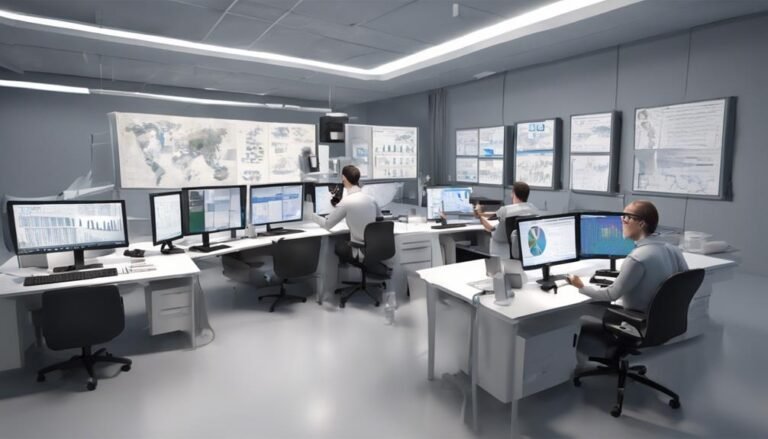Meteorologist Job Description
To excel as a meteorologist, earn a Bachelor's in atmospheric science or related field. Acquire knowledge of weather patterns and climate changes. Gain skills in data analysis for precise forecasts. Seek certification through AMS or NWA. Duties include analyzing weather data, forecasting with computer models, and studying atmospheric phenomena. Use technology for accurate predictions, and refine skills by staying updated. Excelling in communication is crucial for conveying complex data. Collaboration with teams enhances forecasting accuracy. Understand the dynamic challenges of various terrains for fieldwork. Embrace a climate-controlled office for efficient analysis. The intricacies of meteorology involve a rich blend of skills and responsibilities.
Key Takeaways
- Analyzing weather data for current conditions and forecasts accurately.
- Utilizing advanced technology for precise predictions.
- Communicating complex weather information effectively to the public.
- Collaborating with meteorologists and scientists for comprehensive analyses.
- Continuous learning and staying updated on weather forecasting advancements.
Educational Requirements
To become a meteorologist, you typically need at least a bachelor's degree in atmospheric science or a related field. The degree requirements for a meteorologist are essential as they provide the foundational knowledge needed to understand weather patterns, atmospheric conditions, and climate changes. Pursuing a degree in atmospheric science equips you with the necessary skills to analyze data, interpret weather models, and make accurate forecasts.
Additionally, after completing your degree, you may choose to pursue certification through the American Meteorological Society (AMS) or the National Weather Association (NWA). While certification isn't always mandatory, it can enhance your credibility and job prospects in the field. The certification process typically involves passing an exam that tests your knowledge of meteorology, weather instruments, and forecasting techniques. By obtaining certification, you demonstrate your commitment to professionalism and excellence in meteorology. Overall, a combination of a relevant degree and certification can greatly boost your career as a meteorologist.
Job Duties
Meteorologists analyze atmospheric data, interpret weather patterns, and provide accurate forecasts based on their observations and scientific knowledge. Understanding weather patterns is essential in their role, as they must interpret how different atmospheric conditions interact to form various weather phenomena. Their expertise in atmospheric science allows them to predict changes in weather conditions and assess potential risks associated with severe weather events.
| Job Duties | Description | Examples |
|---|---|---|
| Data Analysis | Analyze weather data from satellites, radar systems, and weather stations to understand current conditions and trends in the atmosphere. | Interpret temperature patterns to determine the likelihood of precipitation. |
| Forecasting | Utilize computer models and historical data to forecast weather patterns accurately, including temperature, precipitation, and wind speeds. | Predict the path and intensity of a developing storm system. |
| Research | Conduct research on atmospheric phenomena to enhance understanding of climate change, severe weather events, and other meteorological processes. | Investigate the impact of ocean temperatures on hurricane formation. |
| Communication | Communicate weather forecasts and warnings to the public through various platforms, such as television, radio, social media, and official weather websites. | Issue severe weather alerts to inform the community about potential risks. |
| Collaboration | Collaborate with other meteorologists, climatologists, and scientists to exchange information, share findings, and improve the accuracy of weather predictions. | Work with emergency management agencies to plan for and respond to weather-related disasters. |
Forecasting Responsibilities
Forecasting responsibilities demand a key understanding of weather patterns and the utilization of advanced technology to predict future atmospheric conditions accurately. Meteorologists analyze weather patterns through statistical analysis to identify trends and patterns that can help forecast upcoming weather events.
By studying atmospheric conditions and utilizing mathematical modeling techniques, meteorologists can make predictions about temperature changes, precipitation levels, and severe weather occurrences. They use data from satellites, radar systems, weather balloons, and computer models to create forecasts that inform the public and support decision-making in various industries.
Understanding the complexities of atmospheric dynamics and how different variables interact is essential in accurately predicting weather patterns. Meteorologists must constantly refine their forecasting skills by staying updated on the latest advancements in technology and research to provide the most precise and reliable forecasts possible.
Through a combination of scientific knowledge and technological tools, meteorologists play a crucial role in keeping communities informed and safe in the face of changing weather conditions.
Data Analysis
Analyzing vast amounts of data is an essential aspect of meteorology, enabling accurate predictions of future atmospheric conditions. Meteorologists rely on data interpretation and statistical analysis to uncover trends in weather patterns and atmospheric conditions. By meticulously examining historical data and current observations, meteorologists can identify patterns that help forecast future weather events.
Data interpretation involves extracting meaningful insights from various sources, such as satellite imagery, weather balloons, radar data, and weather stations. Meteorologists use advanced statistical techniques to analyze this data, looking for correlations and anomalies that can offer valuable clues about upcoming weather phenomena. By understanding how different variables interact within the atmosphere, meteorologists can make more informed predictions about temperature changes, precipitation levels, and storm developments.
Through data analysis, meteorologists can create detailed forecasts that inform decision-making in various industries, from agriculture to aviation. The ability to interpret data accurately is essential for providing timely and reliable weather information to the public, helping individuals and organizations prepare for potential weather-related challenges.
Technology Utilization
Utilizing cutting-edge technology is essential in enhancing the accuracy and efficiency of weather data analysis in meteorology. Weather technology plays a significant role in collecting, processing, and interpreting vast amounts of data to generate reliable forecasts. Advanced weather instruments like radar systems, satellites, and weather balloons provide meteorologists with real-time information on atmospheric conditions. These tools help in monitoring temperature changes, air pressure variations, humidity levels, and wind patterns, which are vital for predicting weather patterns accurately.
Data analysis in meteorology heavily relies on sophisticated computer models and simulation software. These tools allow meteorologists to analyze complex weather data sets, identify patterns, and predict future weather conditions with a high degree of precision. By utilizing powerful algorithms and data visualization techniques, meteorologists can interpret data more efficiently, leading to improved forecast accuracy.
Communication Skills
Incorporating effective communication skills is paramount for meteorologists to convey complex weather data and forecasts accurately and thoroughly. Public speaking plays an important role in a meteorologist's job as they often need to present weather information on television, radio, or during public events. Being able to articulate technical information in a clear and understandable manner is essential for ensuring that the public receives accurate and timely weather updates.
Interpersonal skills are also essential for meteorologists to collaborate effectively with colleagues, such as other meteorologists, researchers, and emergency response teams. Building strong relationships and communicating efficiently within a team can lead to better decision-making processes and more accurate forecasting.
Furthermore, meteorologists need to be adept at tailoring their communication style to suit different audiences, whether they're speaking to fellow professionals, government officials, or the general public. By honing their public speaking and interpersonal skills, meteorologists can enhance the dissemination of critical weather information and contribute to overall public safety.
Work Environment
As a meteorologist, you'll find yourself working in climate-controlled office spaces analyzing data and creating forecasts.
Additionally, you may also engage in fieldwork in various terrains to gather firsthand information for accurate predictions.
Collaboration with research teams is essential for developing new forecasting techniques and enhancing meteorological understanding.
Climate-Controlled Office Spaces
Climate-controlled office spaces are crucial for meteorologists to work comfortably and efficiently. Maintaining ideal temperatures is vital for creating a conducive working environment. Meteorologists need focused mindsets to analyze complex weather patterns effectively, and a stable climate helps prevent distractions and equipment malfunctions. Consistent temperatures support accurate data interpretation and informed forecasting. Eliminating fluctuations allows meteorologists to concentrate on detailed analysis and decision-making. Overall, a controlled office setting enables meteorologists to study and predict weather phenomena effectively.
Fieldwork in Various Terrains
Fieldwork in various terrains presents meteorologists with the dynamic challenge of analyzing weather patterns firsthand in diverse environments. This role often requires venturing into extreme weather conditions, such as hurricanes, blizzards, or heatwaves, to gather important data for forecasting and research purposes. Meteorologists may find themselves stationed in remote areas, setting up equipment or conducting field experiments to better understand atmospheric phenomena.
Working in such locations demands adaptability and resilience, as meteorologists must navigate rugged terrains and unpredictable weather patterns. Whether trekking through mountainous regions, traversing deserts, or exploring coastal areas, these professionals play a crucial role in enhancing our understanding of the atmosphere. The hands-on experience gained from fieldwork is invaluable for interpreting meteorological data and improving forecast accuracy.
Collaboration With Research Teams
Working in collaboration with research teams provides meteorologists with a dynamic work environment that enhances their understanding of atmospheric phenomena through collective analysis and interpretation of data. Research collaboration allows for the pooling of expertise and resources, leading to more thorough data collection and analysis.
Teamwork is essential in this process, as meteorologists work closely with researchers to conduct scientific analysis that uncovers patterns and trends in weather data. Through this collaboration, meteorologists can refine their forecasting models, improve the accuracy of their predictions, and contribute to the advancement of meteorological science.
The exchange of ideas and knowledge within research teams fosters innovation and encourages continuous learning, ultimately benefitting both the individual meteorologist and the broader scientific community.
Specializations
As a meteorologist, you can specialize in various areas to enhance your expertise.
Weather Forecasting Techniques focus on predicting short-term weather patterns accurately.
Climate Change Research involves studying long-term trends and their impact on the environment.
Natural Disaster Prediction focuses on anticipating and preparing for events like hurricanes, tornadoes, and floods.
Weather Forecasting Techniques
Utilizing cutting-edge technology and data analysis, meteorologists specializing in weather forecasting techniques employ sophisticated models to predict climate patterns accurately. When focusing on weather forecasting techniques, meteorologists often explore specific specializations to enhance their predictive capabilities.
- Radar Interpretation: Meteorologists interpret radar data to track precipitation intensity and movement accurately.
- Satellite Imagery Analysis: Utilizing satellite imagery, meteorologists can observe cloud cover, storm systems, and other weather phenomena from above.
- Atmospheric Modeling: Meteorologists use advanced atmospheric models to simulate and predict weather patterns based on complex interactions in the atmosphere.
- Weather Pattern Analysis: By analyzing historical weather patterns, meteorologists can make informed predictions about future weather conditions.
Climate Change Research
Meteorologists specializing in climate change research often focus their expertise on specific areas to understand the complex dynamics of our changing environment. Through climate modeling, they analyze trends, project future scenarios, and assess the environmental impact of human activities on the planet.
These specialists play an essential role in evaluating policy implications and recommending global solutions to mitigate the effects of climate change. By studying factors such as greenhouse gas emissions, ocean currents, and atmospheric conditions, they contribute valuable data to the ongoing dialogue on climate change.
Their work is instrumental in shaping strategies that aim to address the challenges posed by a warming world and safeguard the future of our planet for generations to come.
Natural Disaster Prediction
Specializing in natural disaster prediction involves honing expertise to anticipate and analyze catastrophic events with precision and accuracy.
- Utilize advanced technology such as satellite imagery and computer models to track and forecast hurricanes, tornadoes, earthquakes, and other natural disasters.
- Collaborate with emergency management agencies to provide timely warnings and updates to the public, aiding in disaster response efforts.
- Conduct research on historical data and current trends to improve the accuracy of predictions and enhance emergency preparedness strategies.
- Communicate effectively with the public through various media channels to make certain that individuals and communities are well-informed and prepared for potential natural disasters.
Career Outlook
When considering the career outlook for meteorologists, it is essential to acknowledge the increasing demand for professionals with expertise in weather forecasting and analysis. Meteorologists can expect favorable salary trends and high job satisfaction due to the critical nature of their work. Advancement opportunities in this field are abundant, with chances to specialize in areas like climatology or research. Remote work options are also increasingly available, allowing meteorologists to work from various locations while still making a substantial contribution to their field.
| Career Aspect | Details | Impact |
|---|---|---|
| Salary Trends | Increasing demand leads to competitive salaries | Financial stability |
| Job Satisfaction | Contributing to public safety provides fulfillment | Mental well-being |
| Advancement Opportunities | Specializations in climatology or research | Career growth |
| Remote Work Options | Growing availability of telecommuting opportunities | Work-life balance |
Frequently Asked Questions
How Does a Meteorologist Handle Extreme Weather Situations?
In extreme weather situations, you swiftly implement emergency response plans, ensuring safety protocols are followed. You analyze data, issue alerts, and provide critical information to the public. Your expertise is essential for safeguarding lives and property.
What Are the Career Advancement Opportunities for Meteorologists?
You might find it amusing that, ironically, meteorologists often have limited salary expectations and job satisfaction. However, through networking opportunities and professional development, they can advance to higher-paying roles and greater job fulfillment.
Can Meteorologists Work in Research or Academia?
Yes, meteorologists can pursue research opportunities in academia. They can work on groundbreaking studies, publish findings, and teach at universities. Academic positions allow meteorologists to explore deeply into weather phenomena, contributing to scientific advancements.
How Do Meteorologists Stay Updated on the Latest Weather Technology?
To stay updated on the latest weather technology, meteorologists rely on remote monitoring and weather forecasting technology. By incorporating these tools into their daily work, they can analyze data efficiently and provide accurate forecasts.
Are There Opportunities for Meteorologists to Work Abroad?
Yes, meteorologists have various international positions and work opportunities available to them. They can explore global weather patterns and meteorological careers abroad, gaining valuable experience and contributing to different regions' understanding of weather.
Conclusion
In summary, becoming a meteorologist requires a strong educational background in atmospheric science or related field. With a job outlook projected to grow by 8% from 2020 to 2030, the demand for skilled meteorologists is on the rise.
By utilizing advanced technology and communication skills, meteorologists play an essential role in forecasting weather patterns and providing important information to the public.
Consider pursuing a career in meteorology if you have a passion for science and predicting the future.







